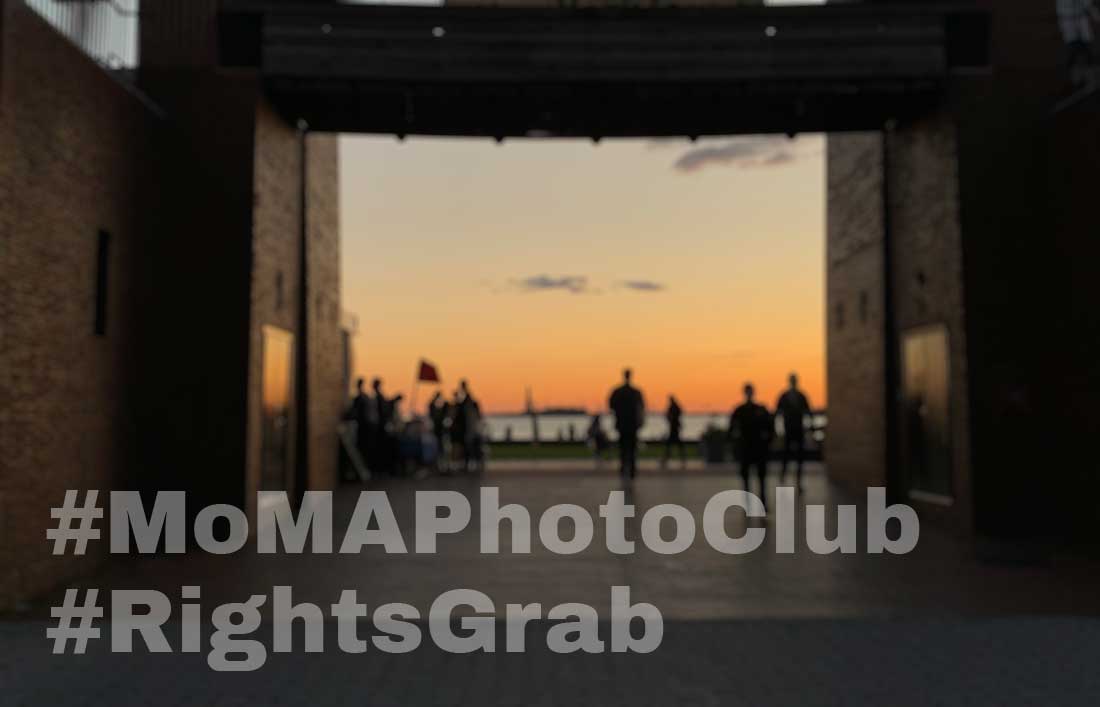
02 Jul #MoMAPhotoClub: That Cool Hashtag is a Rights Grab
The email from MoMA looked inviting. With the subject line, “Join the MoMA Photography Club!” and a beautiful shot of a dancer posing on a rooftop, the invitation was compelling. The institution is encouraging photographers – no experience necessary! – to pick up their cameras and shoot. All one needs to do to participate (and possibly have your photos chosen to be featured by MoMA) is post your photos with the hashtag, #MoMAPhotoClub. But what the invitation doesn’t make clear is that MoMA is claiming an extensive rights grab on any photos using that hashtag.
The MoMA Photo Club claims that their inspiration is the amateur photographers from São Paolo’s Foto-Cine Clube Bandeirante who, in the 1950s, documented Brazil’s vibrant post-war culture. In that vein, the Photo Club exhorts amateur photographers to “get outside and get creative” with each monthly photo challenge. The email and the Club’s website – in bold type — notify viewers that “Select photos will be featured on our social channels, the MoMA website, and on digital screens in select New York City subways.” However, an extensive rights grab is outlined down at the very bottom of the webpage, in smaller, grey type:
By tagging photos using #MoMAPhotoClub, you grant The Museum of Modern Art (“MoMA”) (and those authorized by MoMA) a royalty-free, worldwide, perpetual, sublicensable, non-exclusive license to publicly display, distribute, reproduce, and create derivative works of such photos, in whole or in part (including, but not limited to, any associated captions and handles), in any media now existing or later developed, for any purpose, including, but not limited to, advertising and promotion, and inclusion on MoMA’s website and social media channels.” (bolding ours)
The rights language makes it clear that the photographer retains the copyrights to their images, and that MoMA will not sell the photos or seek other compensation. However, such an extensive granting of rights, in particular, the right to “create derivative works”, diminishes the value of any licensing opportunities. Additionally, by claiming that the submissions can be used for any purpose including advertising, MoMA acquires a significantly valuable asset for free, with no compensation or credit to the photographer.
The danger of such hashtag campaigns is that many, if not most, participants will not realize they are granting MoMA such extensive rights. The point of hashtag campaigns is that they go viral. People see their colleagues, friends, and peers tagging their images with a catchy hashtag and join in. How many people on social media research the origin of a hashtag, and understand the implications of using one?
If challenged, it’s questionable whether MoMA can enforce their rights grab. For a licensing agreement to be enforceable, there must be consent: both parties must understand and agree to the terms. Arguably a licensing agreement hinging on a hashtag campaign does not meet that bar if the photographer doesn’t realize the implications of simply using a hashtag they see on social media. The people using #MoMAPhotoClub may not realize their photo has been used by MoMA. Those that do may not realize that they can protest that use, on the grounds that they did not know the hashtag was bundled with a rights grab.
Nothing excuses a rights grab by a major cultural institution that has built itself on the backs of visual artists.
Rights grabs associated with hashtag campaigns are not new. In fact, companies argue that using their name in a hashtag grants them a non-exclusive right to use that photo. Volvo made that case when it was sued for copyright infringement after reposting photos to its Instagram and Pinterest accounts. The photos had been taken and posted to Instagram by photographer Jack Schroeder, who tagged the images #Volvo Instagram (read TheFashionLaw’s article on Jack Schroeder v. Volvo Motion Group). Their motion to dismiss Schroeder’s copyright infringement lawsuit stated several claims, including that by tagging the photos #Volvo, Schroeder implicitly granted Volvo a non-exclusive right to share the images on other social media platforms. The company’s motion to dismiss the lawsuit was denied in September 2020.
For years, the Guild has joined photography associations in asking social media technology companies to address how their platforms have eroded the ability of visual artists to be fairly compensated. A campaign conducted by ASMP and NPPA asked Instagram to address infringement and sublicensing concerns on its platform. That outreach may be having an effect. In June 2020, Instagram issued a statement that users of its API are not granted the right to sublicense works posted to the platform. They also changed their terms of use to state that users must comply with the restrictions put onto images by the owners of those images.
Regardless, social media hashtags campaigns bundled with rights grabs are not going away. Visual artists are cautioned to research the background behind hashtags, in particular ones which use a company or institution’s name, campaign, or product. If your image has been used by a company or institution without your permission because you used their hashtag, contact them to ask that they remove the image. Be sure to state that you did not agree to their sublicensing terms.
The MoMA Photo Club may honor any requests to take down and stop using images using their hashtag. It would behoove them to abide by the requests of visual artists, “amateur” or not. However, that doesn’t excuse a rights grab by a major cultural institution that has built itself on the backs of visual artists.
